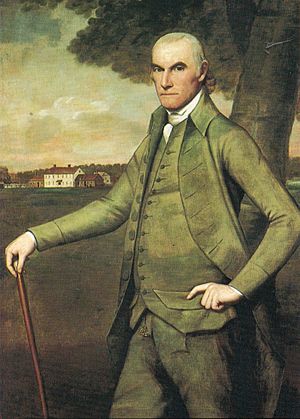William Floyd facts for kids
Quick facts for kids
William Floyd
|
|
|---|---|
 |
|
| Member of the U.S. House of Representatives from New York's 1st district |
|
| In office March 4, 1789 – March 3, 1791 |
|
| Preceded by | New district |
| Succeeded by | Thomas Tredwell |
| Personal details | |
| Born | December 17, 1734 Brookhaven, Province of New York, British America |
| Died | August 4, 1821 (aged 86) Westernville, New York, United States |
| Political party | Democratic-Republican |
| Spouses |
Hannah Jones
(m. 1760; died 1781)Joanna Strong
(before 1821) |
| Residence | William Floyd House |
| Signature |  |
William Floyd (born December 17, 1734 – died August 4, 1821) was an important American leader and wealthy farmer from New York. He is known as one of the Founding Fathers. William Floyd played a big part in the early days of the United States.
He was a delegate, or representative, to the Continental Congress. This was a group of leaders who helped create the new country. He also signed the Declaration of Independence. This famous document declared America's freedom from Great Britain. After the Declaration was signed, the British Army took over his home on Long Island. They used his property as a base for their soldiers for seven years. Even with this, Floyd stayed active in politics during the Revolutionary War. He became a major general in the New York State militia. Later, he was elected to the first U.S. Congress in 1789.
Contents
William Floyd's Early Life
William Floyd was born on December 17, 1734. His family lived in Brookhaven, which is on Long Island in the Province of New York. His family had roots in England and Wales. His parents were Tabitha Smith Floyd and Nicholl Floyd.
William's great-grandfather, Richard Floyd, came from Wales around 1640. He settled in New York and worked as a lawyer. William's grandfather bought a large piece of land, about 4,400 acres, in the area of Mastic Neck. William's father built a house there in 1723, which is where William was born.
His Career and Public Service
After his father passed away in 1755, William took over the family farm. As the American Revolutionary War began, he joined the local militia in Suffolk County. He rose through the ranks to become a Major General.
From 1774 to 1776, he was a delegate for New York in the Continental Congress. This was a very important time for the American colonies. He also served in the New York State Senate from 1777 to 1788. In March 1789, he was elected to the 1st United States Congress. This was the very first Congress under the new U.S. Constitution. He served there until 1791.
William Floyd also helped choose the President of the United States. He was a presidential elector in 1792. He voted for George Washington and George Clinton. The town of Floyd, New York is named after him. He moved to Oneida County in 1794.
In 1795, Floyd ran for Lieutenant Governor of New York. He was part of the Democratic-Republican ticket but did not win. He was a presidential elector again in 1800, voting for Thomas Jefferson and Aaron Burr. He also voted for Jefferson and George Clinton in 1804. In 1808, he was a member of the state senate again.
William Floyd's Family Life
In 1760, William Floyd married Hannah Jones. She was from Southampton, New York. They had three children together:
- Nicoll Floyd (1762–1852)
- Mary Floyd (1764–1805), who married Colonel Benjamin Tallmadge. He was in charge of George Washington's spy ring.
- Catherine Floyd (1767–1832)
After Hannah passed away in 1781, William Floyd married Joanna Strong. She was from Setauket, New York. They had two daughters:
- Ann Floyd (1785–1857), who married George Washington Clinton. He was the son of George Clinton, who was the first Governor of New York and later the fourth Vice President of the United States.
- Elizabeth Floyd (1789–1820)
His Home and Estate
The William Floyd House was the family home. It is located in Mastic Beach. Today, it is part of Fire Island National Seashore and people can visit it. The property includes the house, its grounds, and a cemetery for the Floyd family. For over 200 years, eight generations of the Floyd family lived in and managed this large home and property.
William Floyd's Legacy
William Floyd passed away on August 4, 1821. He is buried in the Westernville Cemetery in Oneida County. His wife, Joanna, died in 1826.
Many places are named after William Floyd, honoring his contributions:
- The William Floyd School District in Brookhaven Town. This includes William Floyd Elementary, Middle, and High Schools.
- William Floyd Parkway in the Town of Brookhaven.
- The Town of Floyd in Oneida County.
- General William Floyd Elementary School in the Holland Patent School District.
- The Floyd Memorial Library in Greenport, Suffolk County, New York.
Images for kids
See also




